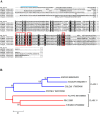A Deep Insight into the Sialome of Rhodnius neglectus, a Vector of Chagas Disease
- PMID: 27129103
- PMCID: PMC4851354
- DOI: 10.1371/journal.pntd.0004581
A Deep Insight into the Sialome of Rhodnius neglectus, a Vector of Chagas Disease
Abstract
Background: Triatomines are hematophagous insects that act as vectors of Chagas disease. Rhodnius neglectus is one of these kissing bugs found, contributing to the transmission of this American trypanosomiasis. The saliva of hematophagous arthropods contains bioactive molecules responsible for counteracting host haemostatic, inflammatory, and immune responses.
Methods/principal findings: Next generation sequencing and mass spectrometry-based protein identification were performed to investigate the content of triatomine R. neglectus saliva. We deposited 4,230 coding DNA sequences (CDS) in GenBank. A set of 636 CDS of proteins of putative secretory nature was extracted from the assembled reads, 73 of them confirmed by proteomic analysis. The sialome of R. neglectus was characterized and serine protease transcripts detected. The presence of ubiquitous protein families was revealed, including lipocalins, serine protease inhibitors, and antigen-5. Metalloproteases, disintegrins, and odorant binding protein families were less abundant.
Conclusions/significance: The data presented improve our understanding of hematophagous arthropod sialomes, and aid in understanding hematophagy and the complex interplay among vectors and their vertebrate hosts.
Conflict of interest statement
The authors have declared that no competing interests exist.
Figures










Similar articles
-
An insight into the salivary gland and fat body transcriptome of Panstrongylus lignarius (Hemiptera: Heteroptera), the main vector of Chagas disease in Peru.PLoS Negl Trop Dis. 2018 Feb 20;12(2):e0006243. doi: 10.1371/journal.pntd.0006243. eCollection 2018 Feb. PLoS Negl Trop Dis. 2018. PMID: 29462134 Free PMC article.
-
Exploring the molecular complexity of Triatoma dimidiata sialome.J Proteomics. 2018 Mar 1;174:47-60. doi: 10.1016/j.jprot.2017.12.016. Epub 2017 Dec 27. J Proteomics. 2018. PMID: 29288089 Free PMC article.
-
2-DE-based proteomic investigation of the saliva of the Amazonian triatomine vectors of Chagas disease: Rhodnius brethesi and Rhodnius robustus.J Proteomics. 2011 Aug 24;74(9):1652-63. doi: 10.1016/j.jprot.2011.02.022. Epub 2011 Mar 8. J Proteomics. 2011. PMID: 21362504
-
The Pharmacopea within Triatomine Salivary Glands.Trends Parasitol. 2020 Mar;36(3):250-265. doi: 10.1016/j.pt.2019.12.014. Epub 2020 Jan 29. Trends Parasitol. 2020. PMID: 32007395 Review.
-
Molecular bases of sensory processes in kissing bugs, vectors of Chagas disease.Curr Opin Insect Sci. 2019 Aug;34:80-84. doi: 10.1016/j.cois.2019.03.010. Epub 2019 Apr 5. Curr Opin Insect Sci. 2019. PMID: 31247423 Review.
Cited by
-
Proteolytic activity of Triatoma infestans saliva associated with PAR-2 activation and vasodilation.J Venom Anim Toxins Incl Trop Dis. 2021 Mar 8;27:e20200098. doi: 10.1590/1678-9199-JVATITD-2020-0098. J Venom Anim Toxins Incl Trop Dis. 2021. PMID: 33747067 Free PMC article.
-
Rhodnius prolixus Hemolymph Immuno-Physiology: Deciphering the Systemic Immune Response Triggered by Trypanosoma cruzi Establishment in the Vector Using Quantitative Proteomics.Cells. 2022 Apr 25;11(9):1449. doi: 10.3390/cells11091449. Cells. 2022. PMID: 35563760 Free PMC article.
-
An insight into the salivary gland and fat body transcriptome of Panstrongylus lignarius (Hemiptera: Heteroptera), the main vector of Chagas disease in Peru.PLoS Negl Trop Dis. 2018 Feb 20;12(2):e0006243. doi: 10.1371/journal.pntd.0006243. eCollection 2018 Feb. PLoS Negl Trop Dis. 2018. PMID: 29462134 Free PMC article.
-
Proteases of haematophagous arthropod vectors are involved in blood-feeding, yolk formation and immunity - a review.Parasit Vectors. 2017 Feb 13;10(1):79. doi: 10.1186/s13071-017-2005-z. Parasit Vectors. 2017. PMID: 28193252 Free PMC article. Review.
-
Exploring the molecular complexity of Triatoma dimidiata sialome.J Proteomics. 2018 Mar 1;174:47-60. doi: 10.1016/j.jprot.2017.12.016. Epub 2017 Dec 27. J Proteomics. 2018. PMID: 29288089 Free PMC article.
References
-
- LAVOIPIERRE MM, DICKERSON G, GORDON RM. Studies on the methods of feeding of blood-sucking arthropods. I. The manner in which triatomine bugs obtain their blood-meal, as observed in the tissues of the living rodent, with some remarks on the effects of the bite on human volunteers. Ann Trop Med Parasitol. 1959;53:235–50. . - PubMed
-
- Champagne DE. Antihemostatic strategies of blood-feeding arthropods. Current drug targets. 2004;4(4):375–96. . - PubMed
-
- Ribeiro JM. Blood-feeding arthropods: live syringes or invertebrate pharmacologists? Infect Agents Dis. 1995;4(3):143–52. . - PubMed
Publication types
MeSH terms
Substances
Grants and funding
LinkOut - more resources
Full Text Sources
Other Literature Sources

